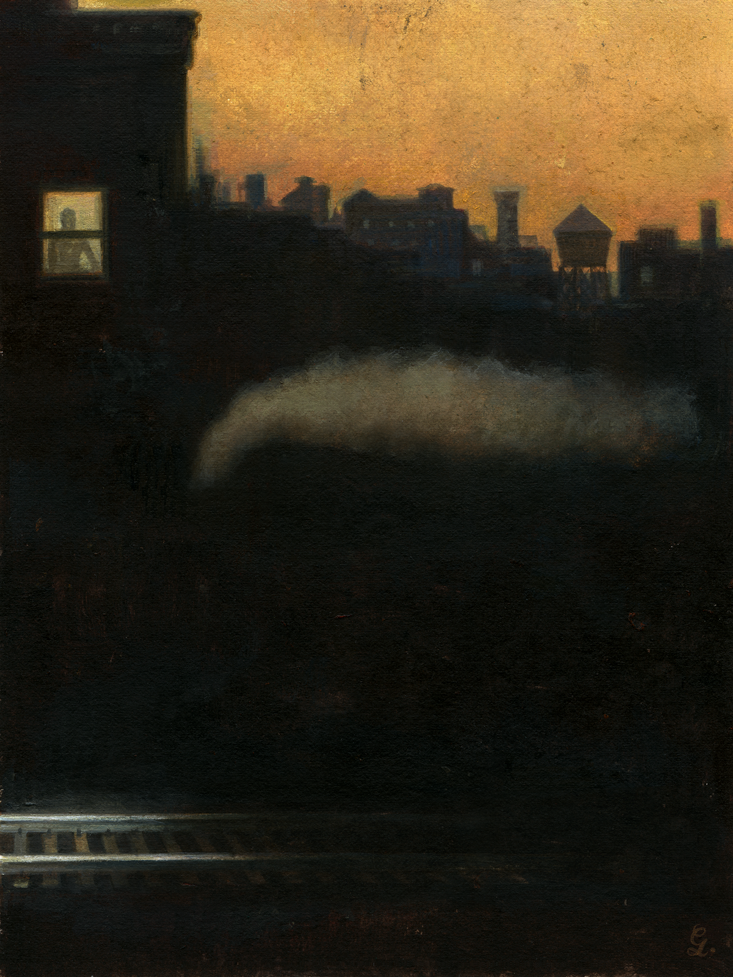“Nothing will come of nothing.”
(William Shakespeare, King Lear)
“Man is equally incapable of seeing the nothingness from which he emerges and the infinity
in which he is engulfed.”
(Blaise Pascal, Pensées, The Misery of Man Without God)
“The… ‘luminiferous ether’ will prove to be superfluous as the view to be developed here
will eliminate [the condition of] absolute rest in space.”
(Albert Einstein, On the Electrodynamics of Moving Bodies)
My most vivid encounter with Nothingness occurred in a remarkable experience I had as a child of 9 years old. It was a Sunday afternoon. I was standing alone in a bedroom of my home in Memphis Tennessee, gazing out the window at the empty street, listening to the faint sound of a train passing a great distance away, and suddenly I felt that I was looking at myself from outside my body. I was somewhere in the cosmos. For a brief few moments, I had the sensation of seeing my entire life, and indeed the life of the entire planet, as a brief flicker in a vast chasm of time, with an infinite span of time before my existence and an infinite span of time afterward. My fleeting sensation included infinite space. Without body or mind, I was somehow floating in the gargantuan stretch of space, far beyond the solar system and even the galaxy, space that stretched on and on and on. I felt myself to be a tiny speck, insignificant in a vast universe that cared nothing about me or any living beings and their little dots of existence, a universe that simply was. And I felt that everything I had experienced in my young life, the joy and the sadness, and everything that I would later experience, meant absolutely nothing in the grand scheme of things. It was a realization both liberating and terrifying at once. Then, the moment was over, and I was back in my body.
The strange hallucination lasted only a minute or so. I have never experienced it since. Although Nothingness would seem to exclude awareness along with the exclusion of everything else, awareness was part of that childhood experience, but not the usual awareness I would locate within the three pounds of gray matter in my head. It was a different kind of awareness. I am not religious, and I do not believe in the supernatural. I do not think for a minute that my mind actually left my body. But for a few moments I did experience a profound absence of the familiar surroundings and thoughts we create to anchor our lives. It was a kind of Nothingness.
To understand anything, as Aristotle argued, we must understand what it is not, and Nothingness is the ultimate opposition to any thing. To understand matter, said the ancient Greeks, we must understand the “void,” or the absence of matter. Indeed, in the fifth century B.C., Leucippus argued that without the void there could be no motion because there would be no empty spaces for matter to move into. According to Buddhism, to understand our ego we must understand the ego-free state of “emptiness,” called śūnyatā. To understand the civilizing effects of society, we must understand the behavior of human beings removed from society, as William Golding so powerfully explored in his novel Lord of the Flies.
Following Aristotle, let me say what Nothingness is not. It is not a unique and absolute condition. Nothingness means different things in different contexts. From the perspective of life, Nothingness might mean death. To a physicist, it might mean the complete absence of matter and energy (an impossibility, as we will see), or even the absence of time and space. To a lover, Nothingness might mean the absence of the beloved. To a parent, it might mean the absence of children. To a painter, the absence of color. To a reader, a world without books. To a person impassioned with empathy, emotional numbness. To a theologian or philosopher like Pascal, Nothingness meant the timeless and spaceless infinity known only by God. When King Lear says to his daughter Cordelia, “Nothing will come of nothing,” he means that she will receive far less of his kingdom than her two fawning sisters unless she can express her boundless love for him. The second “nothing” refers to Cordelia’s silence contrasted with her sisters’ gushing adoration, while the first is her impending one-room shack compared to their opulent palaces.
Although Nothingness may have different meanings in different circumstances, I want to emphasize what is perhaps obvious: All of its meanings involve a comparison to a material thing or condition we know. That is, Nothingness is a relative concept. We cannot conceive of anything that has no relation to the material things, thoughts, and conditions of our existence. Sadness, by itself, has no meaning without reference to joy. Poverty is defined in terms of a minimum income and standard of living. The sensation of a full stomach exists in comparison to that of an empty one. The sensation of Nothingness I experienced as a child was a contrast to feeling centered in my body and in time.

My first experience with Nothingness in the material world of science occurred when I was a graduate student in theoretical physics at the California Institute of Technology. In my second year, I took a formidable course with the title of Quantum Field Theory, which explained how all of space is filled up with “energy fields,” usually called just “fields” by physicists. There is a field for gravity and a field for electricity and magnetism, and so on. What we regard as physical “matter” is the excitation of the underlying fields. A key point is that according to the laws of quantum physics, all of these fields are constantly jittering a bit—it is an impossibility for a field to be completely dormant—and the jittering causes subatomic particles like electrons and their antiparticles, called positrons, to appear for a brief moment and then disappear again, even when there is no persistent matter. Physicists call a region of space with the lowest possible amount of energy in it the “vacuum.” But the vacuum cannot be free of fields. The fields necessarily permeate all space. And because they are constantly jittering, they are constantly producing matter and energy, at least for brief periods of time. Thus the “vacuum” in modern physics is not the void of the ancient Greeks. The void does not exist. Every cubic centimeter of space in the universe, no matter how empty it seems, is actually a chaotic circus of fluctuating fields and particles flickering in and out of existence on the subatomic scale. Thus, at the material level, there is no such thing as Nothingness.
Remarkably, the active nature of the “vacuum” has been observed in the lab. The principal example lies in the energies of electrons in hydrogen atoms, which can be measured to high accuracy by the light they emit. According to quantum mechanics, the electric and magnetic field of the vacuum is constantly producing short-lived pairs of electrons and positrons. These ghostlike particles pop out of the vacuum into being, enjoy their lives for about one-billionth of one-billionth of a second, and then disappear again.
In an isolated hydrogen atom, surrounded by seemingly empty space, the proton at the center of the atom draws the fleeting vacuum electrons toward it and repulses the vacuum positrons, causing its electrical charge to be slightly reduced. This reduction of the proton’s charge, in turn, slightly modifies the energy of the orbiting (non vacuum) electrons in a process called the Lamb shift, named after physicist Willis Lamb and first measured in 1947. The measured shift in energy is quite small, only three parts in 100 million. But it agrees very closely with the complex equations of the theory—a fantastic validation of the quantum theory of the vacuum. It is a triumph of the human mind to understand so much about empty space.
Sadness, by itself, has no meaning without reference to joy.
The concept of empty space—and Nothingness—played a major role in modern physics even before our understanding of the quantum vacuum. According to findings in the mid 19th century, light is a traveling wave of electromagnetic energy, and it was conventional wisdom that all waves, such as sound waves and water waves, required a material medium to carry them along. Take the air out of a room, and you will not hear someone speaking. Take the water out of a lake, and you cannot make waves. The material medium hypothesized to convey light was a gossamer substance called the “ether.” Because we can see light from distant stars, the ether had to fill up all space. Thus, there was no such thing as empty space. Space was filled with the ether.
In 1887, in one of the most famous experiments in all of physics, two American physicists at what is now Case Western Reserve University in Cleveland, Ohio attempted to measure the motion of the earth through the ether. Their experiment failed. Or rather, they could not detect any effects of the ether. Then, in 1905, the 26-year-old Albert Einstein proposed that the ether did not exist. Instead, he hypothesized that light, unlike all other waves, could propagate through completely empty space. All this was before quantum physics.
That denial of the ether, and hence embrace of a true emptiness, followed from a deeper hypothesis of the young Einstein: There is no condition of absolute rest in the cosmos. Without absolute rest, there cannot be absolute motion. You cannot say that a train is moving at a speed of 50 miles per hour in any absolute sense. You can say only that the train is moving at 50 miles per hour relative to another object, like a train station. Only the relative motion between two objects has any meaning. The reason Einstein did away with the ether is because it would have established a reference frame of absolute rest in the cosmos. With a material ether filling up all space, you could say whether an object is at rest or not, just as you can say whether a boat in a lake is at rest or in motion with respect to the water. So, through the work of Einstein, the idea of material emptiness, or Nothingness, was connected to the rejection of absolute rest in the cosmos. In sum, first there was the ether filling up all space. Then Einstein removed the ether, leaving truly empty space. Then other physicists filled space again with quantum fields. But quantum fields do not restore a reference frame of absolute rest because they are not a static material in space. Einstein’s principle of relativity remained.
One of the pioneers of quantum field theory was the legendary physicist Richard Feynman, a professor at Caltech and a member of my thesis committee. In the late 1940s, Feynman and others developed the theory of how electrons interact with the ghostly particles of the vacuum. Earlier in that decade, as a cocky young scientist, he had worked on the Manhattan Project. By the time I knew him at Caltech, in the early 1970s, Feynman had mellowed a bit but was still ready to overturn received wisdom at the drop of a hat. Every day, he wore white shirts, exclusively white shirts, because he said they were easier to match with different colored pants, and he hated to spend time fussing about his clothes. Feynman also had a strong distaste for philosophy. Although he had quite a wit, he viewed the material world in a highly straightforward manner, without caring to speculate on the purely hypothetical or subjective. He could and did talk for hours about the behavior of the quantum vacuum, but he would not waste a minute on philosophical or theological considerations of Nothingness. My experience with Feynman taught me that a person can be a great scientist without concerning him or herself with questions of “Why,” which fall beyond the scientifically provable.
However, Feynman did understand that the mind can create its own reality. That understanding was revealed in the Commencement address he gave at my graduation from Caltech in 1974. It was a boiling day in late May, outdoors of course, and we graduates were all sweating heavily in our caps and gowns. In his talk, Feynman made the point that before publishing any scientific results, we should think of all the possible ways that we could be wrong. “The first principle” he said, “is that you must not fool yourself—and you are the easiest person to fool.”

In the Wachowski Brothers’ landmark film The Matrix (1999), we are well into the drama before we realize that all the reality experienced by the characters—the pedestrians walking the streets, the buildings and restaurants and night clubs, the entire cityscape—is an illusion, a fake movie played in the brains of human beings by a master computer. Actual reality is a devastated and desolate planet, in which human beings are imprisoned, comatose, in leaf-like pods and drained of their life energy to power the machines. I would argue that much of what we call reality in our lives is also an illusion, and that we are much closer to dissolution, and Nothingness, than we usually acknowledge.
Let me explain. A highly unpleasant idea, but one that has been accepted by scientists over the last couple of centuries, is that we human beings, and all living beings, are completely material. That is, we are made of material atoms, and only material atoms. To be precise, the average human being consists of about 7 x 1027 atoms (7,000 trillion trillion atoms)—65 percent oxygen, 18 percent carbon, 10 percent hydrogen, 3 percent nitrogen, 1.4 percent calcium, 1.1 percent phosphorous, and traces of 54 other chemical elements. The totality of our tissues and muscles and organs and brain cells is composed of these atoms. And there is nothing else. To a vast cosmic being, each of us would appear to be an assemblage of atoms. To be sure, it is a special assemblage. A rock does not behave like a person. But the mental sensations we experience as consciousness and thought are purely material consequences of the purely material electrical and chemical interactions between neurons, which in turn are simply assemblages of atoms. And when we die, this special assemblage disassembles. The total number of atoms in our body at our last breath remains constant. Each atom could be tagged and tracked as it subsequently mingled with air and water and soil. The material would remain, scattered about. Each of us is a temporary assemblage of atoms, not more and not less. We are all on the verge of material disassemblage and dissolution.
All that having been said, the sensation of consciousness is so powerful and compelling that we endow other human beings—i.e. certain other assemblages of atoms—with a transcendent quality, some nonmaterial and magnificent essence. And as the assemblage of atoms most important to each of us is our own self, we endow ourselves with a transcendent quality—a self, an ego, an “I-ness”—that blooms far larger and more significant than merely a collection of atoms.
“The first principle” Feynman said, “is that you must not fool yourself—and you are the easiest person to fool.”
Likewise, our human-made institutions. We endow our art and our cultures and our codes of ethics and our laws with a grand and everlasting existence. We give these institutions an authority that extends far beyond ourselves. But in fact, all of these are constructions of our minds. That is, these institutions and codes and their imputed meanings are all consequences of exchanges between neurons, which in turn are simply material atoms. They are all mental constructions. They have no reality other than that which we give them, individually and collectively.
The Buddhists have understood this notion for centuries. It is part of the Buddhist concepts of emptiness and impermanence. The transcendent, nonmaterial, long-lasting qualities that we impart to other human beings and to human institutions are an illusion, like the computer-generated world in The Matrix. It is certainly true that we human beings have achieved what, to our minds, is extraordinary accomplishment. We have scientific theories that can make accurate predictions about the world. We have created paintings and music and literature that we consider beautiful and meaningful. We have entire systems of laws and social codes. But these things have no intrinsic value outside of our minds. And our minds are a collection of atoms, fated to disassemble and dissolve. And in that sense, we and our institutions are always approaching Nothingness.
So where do such sobering thoughts leave us? Given our temporary and self-constructed reality, how should we then live our lives, as individuals and as a society? As I have been approaching my own personal Nothingness, I have mulled these questions over quite a bit, and I have come to some tentative conclusions to guide my own life. Each person must think through these profound questions for him or herself—there are no right answers. I believe that as a society we need to realize we have great power to make our laws and other institutions whatever we wish to make them. There is no external authority. There are no external limitations. The only limitation is our own imagination. So, we should take the time to think expansively about who we are and what we want to be.
As for each of us as individuals, until the day when we can upload our minds to computers, we are confined to our physical body and brain. And, for better or for worse, we are stuck with our personal mental state, which includes our personal pleasures and pains. Whatever concept we have of reality, without a doubt we experience personal pleasure and pain. We feel. Descartes famously said, “I think, therefore I am.” We might also say, “I feel, therefore I am.” And when I talk about feeling pleasure and pain, I do not mean merely physical pleasure and pain. Like the ancient Epicureans, I mean all forms of pleasure and pain: intellectual, artistic, moral, philosophical, and so on. All of these forms of pleasure and pain we experience, and we cannot avoid experiencing them. They are the reality of our bodies and minds, our internal reality. And here is the point I have reached: I might as well live in such a way as to maximize my pleasure and minimize my pain. Accordingly, I try to eat delicious food, to support my family, to create beautiful things, and to help those less fortunate than myself because those activities bring me pleasure. Likewise, I try to avoid leading a dull life, to avoid personal anarchy, and to avoid hurting others because those activities bring me pain. That is how I should live. A number of thinkers far deeper than I, most notably the British philosopher Jeremy Bentham, have come to these same conclusions via very different routes.
What I feel and I know is that I am here now, at this moment in the grand sweep of time. I am not part of the void. I am not a fluctuation in the quantum vacuum. Even though I understand that someday my atoms will be scattered in soil and in air, that I will no longer exist, that I will join some kind of Nothingness, I am alive now. I am feeling this moment. I can see my hand on my writing desk. I can feel the warmth of the sun through the window. And looking out, I can see the pine-needled path that goes down to the sea. Now.
Alan Lightman is a physicist, novelist, and professor of the practice of the humanities at the Massachusetts Institute of Technology. His latest book is The Accidental Universe.






























